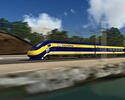To some in the Biden Administration, the supply chain crisis can be dismissed as a loss of East Asian-made consumer trinkets that, as Vox tells us, we could all be better off without—or as White House spokesperson Jen Psaki suggested, amounts to little more than “the tragedy of the delayed treadmill.” Yet, in reality, a broken supply chain is hardly read more »
Transportation
Confronting the Supply Chain Crisis
For a generation, the Long Beach and Los Angeles harbors in California handled more than 40 percent of all container cargo headed into the US and epitomized the power of a globalizing economy. read more »
The Weakness of the Executive Headquarters
Back in 2008 was I one of the first people to start talking about how corporate headquarters were moving back to the global city in the form of the “executive headquarters.” An executive headquarters is one with just the top executives in the firm - from a handful of people up through 500 or so. read more »
Sustainable Suburbia
Visionary images of resilient cities that save the US, or even the world, from climate change. Of downtowns transformed by technology into smart ecotopias. Of urban oases that sprout from scratch in the deserts of the Southwest or the Middle East or Mars. read more »
- Login to post comments
Ford's EV Plants Confirm the Future of Carmaking Will Remain in the Heartland
Jim Farley’s decision to invest $7 billion in green-field new battery and electric-vehicle assembly plants in the mid-South is not only a huge new commitment by the Ford Motor Co. CEO to the fast-gaining propulsion technology. It’s also a mammoth declaration by America’s iconic carmaker that the future of the auto business in the United States will remain anchored in flyover country. read more »
- Login to post comments
EV Buyers Beware — Fires, Scarce Charging, and Parking Restrictions
In the wake of a series of severe EV battery fires, one of the largest vehicle manufacturers in the world, General Motors has just issued safety recommendations for Bolt EV’s: read more »
- Login to post comments
Amid Airline Re-Set, Ensure We're Flown Into — Not Over
Amid the ups and downs of the post-Covid airline business, one disturbing constant has settled over the ever-changing route maps: In Flyover Country, we’re still in danger of losing many of our aeronautic lifelines to one another and to the rest of the country and the world. Among other effects, countering that problem will be a big boon to private aviation. read more »
Exposure Density, Overcrowding and COVID Death Rates: Update
In their new book, Harvard economists Edward Glaeser and David Cutler characterize COVID and related issues as an “existential threat to the urban world, because the human proximity that enables contagion is the defining characteristic of the city” (see our review, Survival of the City: The Need to Reopen the Metropolitan Frontier (Review). read more »
- Login to post comments
Mag-Lev May Be Dead; TX HSR on Life Support
A Maryland circuit court judge >ruled last week that the Baltimore-Washington Rapid Rail Company did not have the >power of eminent domain and could not stop a development on land that the maglev promoter needed to use for its proposed line. read more »
- Login to post comments
Comparing the World Before 1900 to Today
For thousands of years before 1900, the population of the world hovered around one billion on the entire planet. In the short 120 years since 1900 the world population has “exploded” to the current 8 billion now living on this planet. What caused that quick growth from 1 to 8 billion? read more »






















